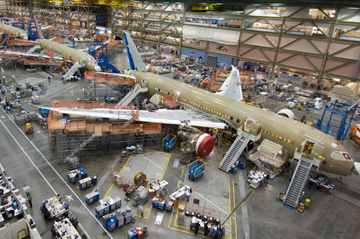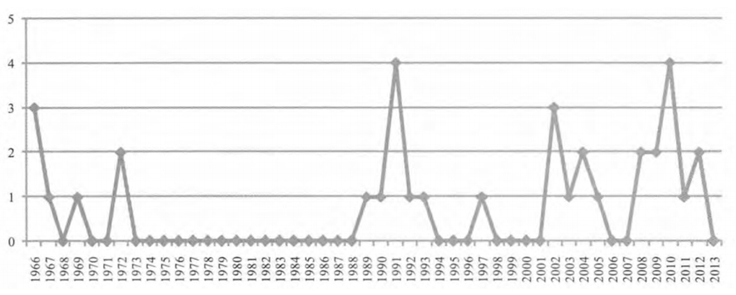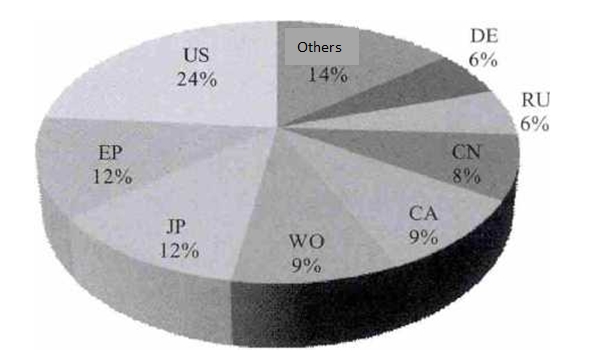As the biggest producer and consumer of
titanium products, the US, with its three magnates of Timet, RTI, and ATI, took
up the monopoly position in the market and thus has had significant impact on
the development of the titanium industry.

The three enterprises, who are more
concerned with the quality rather than the quantity of the patents, are active
in promoting the layout of patents. In terms of the emphasis of the layout, the
enterprises paid more attention to the layout of core and fundamental patents,
and the techniques were mostly concentrating on the midstream of the industrial
chain. In terms of the phase of development, the layout has still been in the
phase of combination and construction, and therefore there’s a very obvious
intention to complete and supplement the patent portfolio through commercial
acquisition. In terms of the strategy of layout, the areas of patent layout
were highly consistent with the target market.
Due to the highly complex techniques for
the titanium melting, there are only four countries--the US, Russia, Japan, and
China--mater the integrated techniques for processing titanium, among which the
US was the pioneer of the industry.
The titanium alloy industry shows an
obvious characteristic of oligopoly and dependency. The production of the major
three of the industry - TIMET (has already been purchased by PCC with no marked
changes in its business direction), RTI, and ATI - have accounted for about 90%
of the total output in the US, and thus it is these companies that determined
the technological level and development direction of the titanium alloy
industry in the US.
As time went on, these three companies have
still been on their way to increase the market share. With the oligopoly and
dependency turned more and more intensified, the magnates of the titanium alloy
have an obviously stronger influence to the industry than that of other
industries.
Profiles of Three Magnates of Titanium
Alloy Industry in the US
1. Timet
Established in 1990, Timet has been one of
the dominant producers of the titanium products with its headquarters located
in Dallas, the US. At the same time, Timet has also been the biggest producer
of the titanium sponge and the recycler of the titanium defective materials in
the US with the principal products of titanium sponge, casting products, rolled
products and finished products. As civil aviation department is the major
customer for Timet, the company formulated its long-term development strategy
as maximizing its value in the core airline business and, at the same time,
expanding the utilization in non-aviation market and developing new products.
2. RTI International Metals
With the headquarters located in Niles,
Ohio, RTI is an old-brand and professional producer of aeronautic titanium
products and high-end titanium manufactured products with glorious history of
more than 50 years. The company, whose predecessor was RMI (the top two
titanium manufacturer in the US), devoted itself to the producing and selling
of aircraft-grade titanium alloy slab and has been the major supplier for
Boeing, Airbus, and BAE systems.
3. ATI (Array Technology Industry)
ATI, with the headquarters located in
Pittsburgh, Pennsylvania, is the biggest producer of special steel across the
world and the third producer of titanium products in the US. ATI is a regular
supplier for the titanium products of aviation and biomedical fields. The major
products of the company can be categorized into: flat rolled products,
high-performance metals, and engineering products.
Analysis
on Patent Layout of Timet
1.Profile of Timet’s Patent Layout
Timet started very early in applying global
patents. The company focused more on the quality rather than the quantity of
the patent. Timet began to apply the patent relative to the titanium ally since
1966, as shown in the Fig.1, however, the companies had not deliberately
applied the patents to protect its scientific results before 2000, so we can
see there’s a vacancy in Fig.1.
Fig. 1 Application Profile of Timet’s
Global Patents over the Years

Source: Espacenet Patent Search of European
Patent Office (EPO)
Timet has laid more emphasis on the patents
application since 2000. However, generally, the patents of Timet was not
characterized by the high quantity, since there were only 35 patents Timet
applied in global titanium alloy industry up to September 2014, with the
highest annually application of 5.
The more revenue the company gained from an
area, the larger share of patents layout it would allocate in that area. For
example, there were 24% of the patents in the US and 9% of the patents in
Canada, and thus 60% of company’s revenues came from North American market.
AS European market took up 31% of company’s
revenue, it has been the second target for the patent layout, among which Timet
submitted 12% of the patents application to European Patent Office and 6% in
Germany. Besides, Timet also quite valued its third market of Japan, in which
the company submitted 12% of the patents application.
Although the proportion of the revenue from
China’s market was not very high, Timet allocated 8% of patents in China, prior
to Russia and Germany. That’s to say, with the development of China’s civil
airline business and opening up, China has been a very promising market for
Timet and the company has already prepared itself in the level of patents to
enter China’s market.
Fig.2 Geographical Distribution of Timet’s
Global Patents Application

Timet has very comprehensive categories in
patents with the layout in upstream, midstream, and downstream of the industry
chain, while the focus of the layout laid on the midstream areas involving the
processing techniques of the titanium alloy. In terms of the patents of Timet
applied in China since 2003, all remains valid but one doesn’t.
Up to September 2014, there were 8 valid
patents for Timet in China. In terms of technology structure, only one patent
was for the manufacturing method of titanium alloy, the other seven were all
for the research of new titanium alloy. In terms of the technology
characteristics, Timet’s patents mainly emphasized on the processing techniques
involved four aspects -- anti-corrosion, high strength, thermostability, and
low cost.
1. Strategy of Timet’s Patent Layout and
Its Characteristics
(1) With
the characteristics of multicore, low aggressivity, and low costs on the
application and maintenance, the patents layout of the Roadblock Pattern was
adopted by Timet. The patents concerned the characteristics of titanium alloy,
each of which was not very closely linked with the others.
From 1960s to 2010, Timet has always kept
the above-mentioned layout in terms of patent application. With the help of
company’s comprehensive and accurate grasp on the globally advanced technology
and the correct cognition to the innovative ability of its competitors, the
layout of Roadblock was good at fighting against the competitors in the
titanium alloy products.
However, there’s still a space for
competitors avoiding and finally breaking through the roadblocks by the means
of Design Around. More importantly, it would give competitors inspiration in
their research and thus reduce the R&D costs.
(2) The
recent tendency of patent layout can be summarized as two aspects:
strengthening the patents layout on the low-cost characteristics and weakening
the layout on the processing techniques. Timet started its development on the
low-cost titanium alloy from 1993, which was relatively late compared with
others, and the company then applied three low-cost patents in 2011, 2012, and
2013 respectively.
Contrarily, most of the patents concerned
processing techniques were applied in early stage of Timet, for example, the
US2985747 was applied in 1961, US3239440 was in 1966, all of which are invalid
as there’s only 20 years of the term of patent protection. The nearest
application was in 2005 from its purchased company Axel Johnson.
In the recent years, Timet intended to
improve the producing and processing ability by the means of internal
extension, long-term third party agreement, and potential joint-venturing and
purchasing so as to meet the requirements of the promising titanium market.
After gradually purchasing most of European titanium enterprises, including IMI
of the UK, CEZUX of France, TIMET of Germany, and VALINOX of France, the Timet
itself was purchased by a downstream enterprise – PCC -- in the US at the end
of 2012 and transferred to be an important department of the first phase of
industry chain of aviation.
*This article is edited and translated by
CCM. The original version comes from China Invention & Patent.
About
CCM:
CCM is the leading market intelligence
provider for China’s agriculture, chemicals, food & ingredients and life
science markets. Founded in 2001, CCM offers a range of data and content
solutions, from price and trade data to industry newsletters and customized
market research reports. Our clients include Monsanto, DuPont, Shell, Bayer,
and Syngenta. CCM is a brand of Kcomber Inc.
For more information about CCM, please
visit www.cnchemicals.com or get in
touch with us directly by emailing econtact@cnchemicals.com or calling +86-20-37616606.